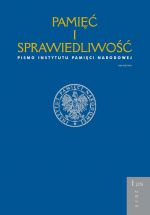Dzisiejsze wczoraj. Pamięć o wojnie w polskiej sztuce współczesnej po 1989 roku
Yesterday Today: Memory of the War in Polish Contemporary Art after 1989
Author(s): Magdalena LorencSubject(s): History, Fine Arts / Performing Arts, Cultural history, Recent History (1900 till today), Sociology of Art
Published by: Instytut Pamięci Narodowej
Keywords: collective memory memory of war; memory of the Holocaust; Polish-Jewish relations; critical art; visual arts; Polish contemporary art after 1989; commemorative themes in art
Summary/Abstract: The purpose of this text is to attempt a synthetic portrayal of the issue of memory of the Second World War as a source of inspiration in Polish contemporary art since 1989. The year 1989, which marked the beginning of systemic transformation in Poland, was also the beginning of the process of transformation of the paradigm of collective memory of World War II. The appearance of issues omitted in the institutionalized discourse of the period of the Polish People’ s Republic contributed to an increase in artists’ interest in the mechanisms of constructing the collective image of the past. The particular ‘memory boom,’ which involved a sharp increase in the number of publications on so-called ‘white spots’ in the history of Poland, also manifested itself in the visual arts, among others, in the works of Mirosław Bałka, Zbigniew Libera, Wilhelm Sasnal, Piotr Uklański and Artur Żmijewski. Most of the works created in the 1990s and in the first decade of the 21st century concerned the memory of the Holocaust and Polish-Jewish relations during the German occupation. In many cases, the means of artistic expression employed by their creators evoked controversy and objections by those who found them inappropriate. The basic objections raised against artists referring to ‘war issues’ were: the instrumental references to the issue of the Holocaust, dictated by trends, and the lack of deep reflection on the attitudes ofperpetrators, victims and witnesses of the events at that time. The fact that artists drew from collective images brought with it other effects also. Many works created in this period served the following functions: c a t h a r t i c – involving the purification through art of the recipient’ s feelings and emotions, h e u r i s t i c – resulting from treating creation and its outcomes as a research process whose important elements include the posing of hypotheses and their verification, m n e m o t e c h n i c a l – being an exercise in memory through the medium of art and, finally – c o m m e m o r at i v e, embedded – following Pierre Nora – in the era of commemoration and the call to remembrance. The manners of portraying themes of memory of the war in Polish contemporary art since 1989 seem to have confirmed the social aspect of artistic creation, involving – in the case being discussed – the exposing of, but also the formation of collective images of the past.
Journal: Pamięć i Sprawiedliwość.
- Issue Year: 25/2015
- Issue No: 1
- Page Range: 221-241
- Page Count: 21
- Language: Polish

